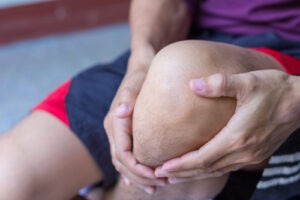 If you have suffered a knee injury, it is important to know the difference between an ACL tear and an MCL tear. ACL stands for anterior cruciate ligament and MCL stands for medial collateral ligament. Both of these ligaments are located in the knee and they serve different purposes, so it is important to understand the difference between an ACL tear and an MCL tear in order to properly treat the injury. In this blog post, we will discuss the differences between an ACL tear and an MCL tear and provide tips on how to tell the difference. At the practice of Steven C. Thomas, MD and Gregory T. Bigler, MD. Our board certified surgeons specialize in ACL and MCL surgery in the Las Vegas area.
If you have suffered a knee injury, it is important to know the difference between an ACL tear and an MCL tear. ACL stands for anterior cruciate ligament and MCL stands for medial collateral ligament. Both of these ligaments are located in the knee and they serve different purposes, so it is important to understand the difference between an ACL tear and an MCL tear in order to properly treat the injury. In this blog post, we will discuss the differences between an ACL tear and an MCL tear and provide tips on how to tell the difference. At the practice of Steven C. Thomas, MD and Gregory T. Bigler, MD. Our board certified surgeons specialize in ACL and MCL surgery in the Las Vegas area.
Symptoms
A torn ACL (anterior cruciate ligament) is often characterized by a sharp pain that occurs suddenly in the knee area, often following a sudden twist or pivot of the knee. You may also experience swelling and joint instability, as well as difficulty bearing weight on the affected knee. An MCL (medial collateral ligament) tear, on the other hand, is typically accompanied by pain along the inner side of the knee joint, as well as swelling, tenderness and possibly bruising. Depending on the severity of the tear, you may also experience instability in the knee joint.
It’s important to note that not all knee injuries require ACL or MCL surgery. If you suspect you have torn one of your knee ligaments, it’s best to visit an orthopedic surgeon who can diagnose and treat your injury accordingly. The surgeon will likely recommend rest, icing, compression and elevation to reduce inflammation and pain. For more severe injuries, he or she may suggest ACL or MCL surgery in order to repair or reconstruct the torn ligament.
Causes
ACL tears can be caused by a variety of activities. The most common cause is when a person makes a sudden change in direction while running or jumping. This sudden shift can put too much stress on the ACL and cause it to tear. In some cases, ACL tears may be caused by a direct blow to the knee, such as during a tackle in sports.
MCL tears are usually caused by a direct blow to the outside of the knee. This often occurs during contact sports, such as football, soccer, or skiing. Injuries to other ligaments in the knee can also lead to MCL tears.
In both cases, surgery is typically required to repair the injury. An orthopedic surgeon will examine the knee and determine the extent of the injury. Afterward, they will determine if ACL surgery or MCL surgery is needed to repair the tear. Depending on the severity of the tear, a full or partial reconstruction of the ligament may be necessary. In some cases, a complete replacement of the ligament may be needed.
Recovery
Recovery from an ACL tear requires surgery, which is typically performed by an orthopedic surgeon. The goal of the ACL surgery is to reconstruct the ligament using a tendon graft taken from another part of the body or a donor. After the surgery, it is important to do physical therapy to strengthen the muscles around the knee and rebuild range of motion. Depending on the severity of the injury, recovery time for ACL surgery can range from three months to one year.
For a torn MCL, recovery can take up to eight weeks depending on the severity of the tear. The primary treatment for a torn MCL is rest and physical therapy. During the recovery process, a brace may be used to limit the movement of the knee and reduce swelling. Physical therapy may involve exercises to help strengthen the leg muscles and restore range of motion. If the injury is severe enough, surgery may be required to repair the damaged ligament.
Prevention
There are several ways to reduce your risk of an ACL or MCL tear. Strengthening the muscles around the knee, especially the quadriceps and hamstrings, can help support the ligaments and protect them from injury. Additionally, it is important to warm up properly before physical activities and avoid any sudden, awkward movements while playing sports. Wearing appropriate protective gear, such as knee pads and braces, can also help reduce your risk of ACL and MCL tears. Lastly, it is essential to stay well hydrated and rest adequately between workouts to ensure proper recovery. Taking all of these precautions can help keep you safe and prevent ACL and MCL tears.
Contact Board Certified Surgeons Dr. Bigler or Dr. Thomas at the Knee and Shoulder Institute in Las Vegas, NV to Schedule an Appointment:
If you would like to schedule an appointment or learn more about the Knee and Shoulder Institute procedures & treatments performed by Las Vegas, Nevada board-certified surgeons Steven C. Thomas, MD and Gregory T. Bigler, MD. Contact the office today click here.
Serving patients from and around greater Las Vegas, Lake Havasu, Bullhead City, Mesquite, Pahrump, Nevada
